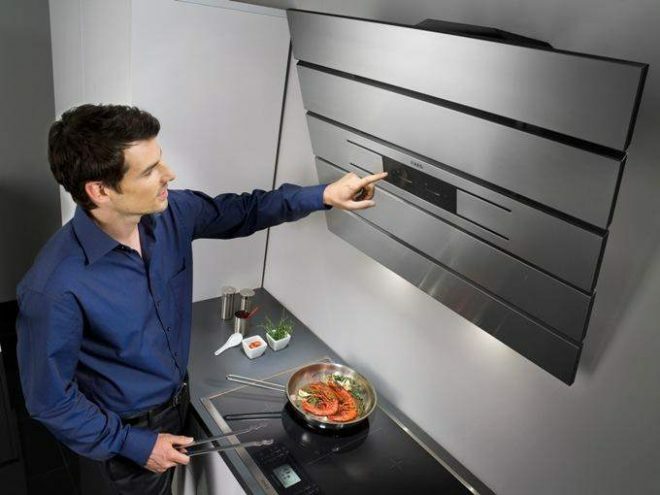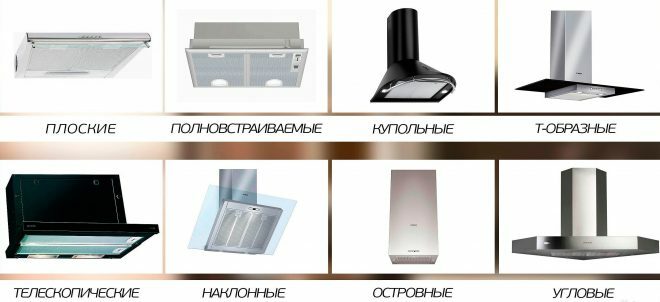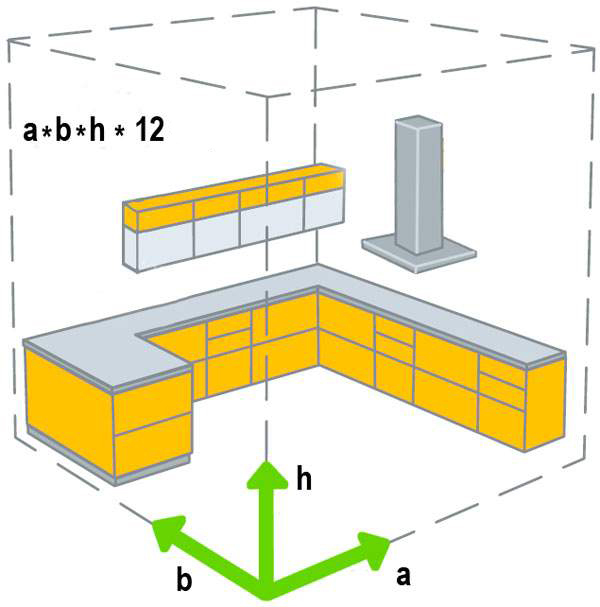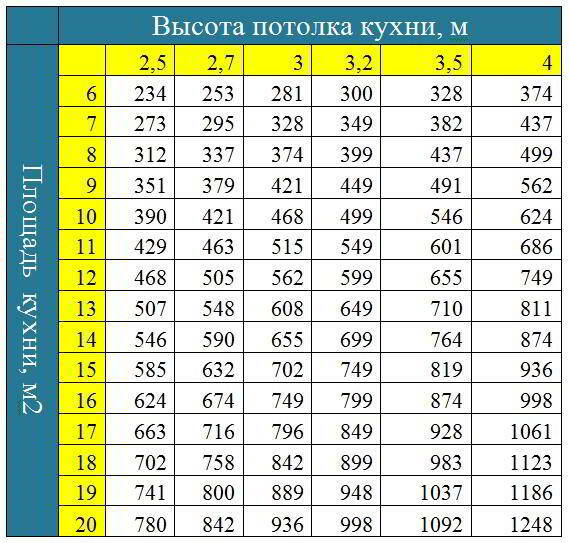If you are tired of constantly ventilating the kitchen, and the issue of air purification remains unresolved, then it's time to purchase a powerful hood of the required model. Before buying, you need to make sure that you have taken into account all the nuances - from functionality to decorative features. And for this you need to get familiar with the characteristic qualities of the most common models available on sale, and also calculate their power.

Among the huge range of cooker hoods, you can choose models of all sizes and shapes. Many buyers choose a beautiful design or a well-known brand first. But the appearance of these devices is much less important than their technical parameters - the power and volume of air pumped per unit of time.
Attention! Earned on our website kitchen designer. You can familiarize yourself with it and design your dream kitchen for free! May also come in handy wardrobes designer.
An improperly selected hood for a given room will not be able to effectively purify the air in it. Its performance indicator, measured in m
3/ h, affects how much polluted air it can let through in an hour. With the help of special calculations according to a simplified formula, you can independently choose the most suitable exhaust technology for your kitchen. A more accurate calculation can only be made by a competent engineer.What is the difference between a hood and ventilation
The ventilation system is a network of ducts built into the walls with an exit to the outside of the building for exhausting exhaust air from the room. In this case, the inflow of fresh air occurs through door and window openings in a natural way.
This air exchange system, according to sanitary standards, must be installed in all living quarters. But it is not very effective, and even more so it is not able to localize and remove odors, fumes, soot and other "delights" of everyday life. To prevent them, forced ventilation is installed - an exhaust. It collects all the vapors from the hob and directs them through the duct to the ventilation system.
Exhaust device
In principle, they are all similar to a vacuum cleaner, but with different functions. Modern exhaust devices come in different designs, depending on the purpose - some only remove the polluted air, while others filter it and return the already purified air back. According to the method of cleaning, they are divided into flow, recirculation and combined, which combine both options.
- Flow hoods equipped with metal or plastic pipes (round, square, corrugated) for connection to the ventilation system, which can be rigid or flexible. The lower parts of the device consist of filters (grease traps), which retain soot and grease. They are disguised behind decorative panels. Fans and special motors are located inside. Behind them is an air duct connected to ventilation.
- Recirculating they work autonomously, without being connected to ventilation, therefore they do not have pipes, which makes them look more aesthetically pleasing. Inside their cases, after the fans, there are replaceable, very thin carbon filters. For coarse cleaning, the filters are made of durable aluminum, they can simply be washed with detergents. Outwardly, the principle of the structure of the cases is the same as that of the flow-through ones.
The exhaust system is powered by an electrical network. Everything is very simple - it plugs into the socket, the button with the selected mode is pressed (denoted by numbers 1-3), the engine picks up speed. The most convenient hoods for connection are with touch displays or with remote control (using the remote control or voice commands).
Types of exhaust systems by shape and placement
According to the features of the structure of the case, there are several varieties:
- Flat - the most compact, no additional installations. Suitable for small spaces. But they have a short lifespan and must be replaced periodically. Among the flat ones, there is a kind of inclined, located at an angle to the hob and small in size.
- Dome - powerful and functional, good for cleaning large rooms. They are quite large and have the shape of hemispheres or pyramids.
- Also produced cylindrical (adjustable in height), square, conical, round and other non-standard forms.
- Embedded models differ from the previous ones by the possibility of their disguise in furniture, ceiling, niche in the wall.

There are hoods according to the features of placement:
- suspended - mounted to the wall or ceiling in any area of the kitchen;
- insular - attached to the ceiling in the center of the room;
- corner - are installed at two adjacent walls for more rational use of space.
Requirements for exhaust devices and their installation in the kitchen
To ensure the efficient and safe operation of these devices, several installation guidelines must be followed:
- The size of the intake opening must be larger than the area of the hob.
- The distance from the surface of the stove to the hood should be at least 70-80 cm to avoid overheating.
- Its capacity must be such as to ensure a complete replacement of air at least 10 times per hour.
- If the kitchen does not have access to a special ventilation shaft, then it is better not to connect it to a regular one so as not to disrupt its operation, and even better - to install a recirculation model.
How to calculate the power and performance of a kitchen hood depending on the area of the room
The higher the extraction power, the faster the air will be cleaned. The required performance for a given room can be found in the table, where the kitchen area and its height are taken as the basis for calculations. The lowest performance is in the cheapest models, about 200-300 m3/ч. They can only be installed in small kitchens and on the condition of not very frequent cooking on the stove. If the hob is used often, then the capacity should be at least 600 m3/ч.

The formula for calculating the power of the kitchen hood
Calculations can be done using a simplified formula yourself:
Q = S × H × 12
Q - exhaust power (m3/ч);
S - kitchen area;
H - the height of the kitchen;
12 - coefficient (number of air change cycles per hour)

According to sanitary standards, 10-15 air replacement cycles should take place within an hour. The factor of 12 is the selected mean.
For example, S = 10 m2, H = 2.5 m2
With these values, it turns out:
Q = 10 × 2.5 × 12 = 300 m3 / h.
Other factors to consider
Calculations according to the formula have an average value, because other nuances must also be taken into account:
- Type of hob. For an electric stove, the reading of the coefficient can be up to 15, because besides the fumes from the products, no other substances enter the air. But with a gas stove, harmful substances from gas combustion also enter the air. In this case, the coefficient is taken from 20.
- Hood type. With a flow-through one, it is necessary to take into account the throughput of the existing ventilation shaft. With recirculation, this factor does not matter.
- The layout of the premises. If there is an open entrance to the next room or the door often opens there, then it is necessary to take into account the large area of the room in the calculations.
Choosing a kitchen hood
If funds allow you, choose a model that works in two modes - combined (read more here). This is a more convenient option. There are already models on sale that work almost silently - with a level of no more than 40 dB. An alternative to one powerful engine is a system with two, but less power, which emit much less noise. Fans play an important role in the operation of exhaust devices. They best withstand maximum tangential and diametrical loads. Hood size should be larger than the area of the hob so that steam and dirt do not get on the ceiling.
Video: rules for calculating the required hood performance
Among the abundance of models presented for sale in stores, it is difficult to immediately navigate and make the right choice. The correct calculation of the power of the exhaust system, the choice of a model of the appropriate size and mode of operation will allow you to create a healthy microclimate and safe conditions in the house.


